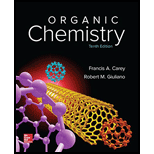
Interpretation:
It is to be explained why the reaction of one of the trimethylcyclohexanols shown with hydrogen chloride gives a single product while the other gives a mixture of two stereoisomers.
Concept introduction:
Secondary and tertiary alcohols react with hydrogen halide by an
Tertiary carbocations are stable and allow both the faces to become equivalent with respect to their surroundings. However, sterically less hindered face is favorable.
In case of alcohols, the first step in an
The alkyloxonium ion dissociates to a water molecule in the second step, and a carbocation is formed.
The third step is the reaction of a carbocation with the nucleophile. The nucleophile uses an unshared electron pair that can be used to form a covalent bond between the carbon atom of a carbocation and the halide ion.
For sterically hindered cyclohexanols, the sterically less hindered sites are favorable to form a product.
Trending nowThis is a popular solution!

Chapter 5 Solutions
Solutions Manual for Organic Chemistry
- What is the major product obtained from treating an excess of each of the following compounds with Cl2 in the presence of ultraviolet light at roomtemperature? Disregard stereoisomers.arrow_forwardCompound A is first reacted with methylamine in the presence of acid and then treated with NaBH3CN. Using the spectroscopic data given, what is the structure of the product after step 1?arrow_forwardEach of the following reactions has been described in the chemical literature and gives a single organic product in good yield. Identify the product of each reaction.arrow_forward
- Starting from the enantiomerically pure alkyl chloride, provide a two-step synthesis to arrive at the racemic mixture of epoxides shown below as the major products.arrow_forwardProvide a reasonable stepwise mechanism for the following transformation. Show the structure of any intermediates and use the arrow formalism to account for electron flow. Draw the structure of the regioisomer that might form and suggest a reason why it would not be produced.arrow_forwardWhat reaction presented in this chapter is occurring in the following equation? Explain the resulting stereochemistry of the reaction.arrow_forward
- What is the major product obtained from treating an excess of each of the following compounds with Cl2 in the presence of ultraviolet light at room temperature? Disregard stereoisomers.arrow_forwardDefine Hemiacetal, Acetal and Ketal. Give the structure of the product from the reaction of propanal with 1M ethanolin dry acid. What happens when Further 1M of ethanol is added to above?arrow_forwardExplain this observation: Ethyl 3-phenylpropanoate (C6H5CH2CH2CO2CH2CH3) reacts with electrophiles to afford ortho- and para-disubstituted arenes, but ethyl 3-phenylprop-2-enoate (C6H5CH=CHCO2CH2CH3) reacts with electrophiles to afford meta- disubstituted arenes.arrow_forward
- Cyclobutane fracts with bromine to give bromocyclobutane, but bicyclobutane reacts with bromine to give 1,3-dibromocyclobutane. Account for the differences between the reactions of thee two compounds.arrow_forwardWhat condensation product would you expect to obtain by treatment of the following substances with sodium ethoxide in ethanol. Cycloheptanonearrow_forwardShow how the m-bromobenzonitrile can be synthesized from benzene:arrow_forward
 Organic ChemistryChemistryISBN:9781305580350Author:William H. Brown, Brent L. Iverson, Eric Anslyn, Christopher S. FootePublisher:Cengage Learning
Organic ChemistryChemistryISBN:9781305580350Author:William H. Brown, Brent L. Iverson, Eric Anslyn, Christopher S. FootePublisher:Cengage Learning
